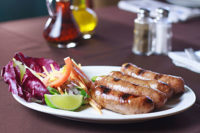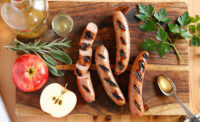Sausage report: Shifting the sting
As pork prices have normalized, sausage processors began adding strong, unique flavors that sting the senses.

Sausage prices are down and both processors and foodservice operators are offering more flavorful, unique options.

The top 10 frozen sausage brands over a 52-week period ending April 17, 2016.


The top 10 refrigerated dinner sausage brands over a 52-week period ending April 17, 2016.




The summer grilling season is upon us, and sausages are certainly a longtime standby at most holiday get-togethers. Turns out, they haven’t lost a step at foodservice, either.
“Sausage continues to be a popular and versatile menu item and ingredient on menus,” says Joe Garber, marketing coordinator at Datassential, based in Chicago. “It’s currently found on nearly 60 percent of menus and has grown on menus over the shorter and longer term (up 1 percent over last four years and up 8 percent over last 10 years).
As a bonus, sausage prices are down as both processors and foodservice operators offer more flavorful, unique options.
Sausage certainly hasn’t been immune to the increased prices from pork’s supply issues the past two years, and consumers noticed.
“In 2015, consumers made good on promises to leave the meat case in response to high prices,” says Sarah Schmansky, director of account services, Nielsen Perishables Group, based in Chicago. “The sausage category was not immune to supply and pricing issues — in 2014, the average retail price of sausage increased 10 percent compared to 2013, and dollar sales increased 7 percent, while volume sales decreased at a slightly slower rate than other beef and pork categories, down 3 percent compared to the previous year.”
A return to more “normal” pricing has boosted volume sales for the $3.9 billion sausage category, but contributed to a slight dollar sales decrease, during the latest 52 weeks ending April 30, says Schmansky.
Since last April, sausage dollar sales have decreased 2 percent, which corresponded with a 6 percent decrease in the average retail price of sausage, according to Nielsen. Sausage currently makes up 7 percent of total meat department sales.
“Shoppers responded to this price decrease by purchasing more pork — volume sales increased 5 percent,” says Schmansky.
Experimenting with flavor
Flavor profiles that posted high dollar and volume growth during the latest 52 weeks include Polish sausage and chicken sausage (each increased dollar sales 10 percent compared with the previous year) and products with apple in them (up 12 percent in dollar sales and 17 percent in volume), notes Schmansky.
“People buy sausage for its flavor,” says Patrick Fleming, director of market intelligence and innovation, National Pork Board, based in Des Moines, Iowa. “Custom, tailored flavors from foodservice are appearing at retail now like chipotle, Monterey Jack, hatch green chili and smoky bourbon.”
According to Fleming, chorizo sausages are up 23.8 percent, while traditional brats remain popular with a 45.8 percent increase in sales.
Consumers — and processors — are more willing to try new flavors and formats.
“We’re looking at sausage as more of a convenient, nutritious, protein conveyance rather than simply a traditional means of preserving meat,” says Chris Salm, co-owner of Gilbert’s Craft Sausages, based in Wheaton, Ill. “For us, that means we’re no longer bound by traditional flavors, herbs and spices; and if something sounds interesting, we’re going to try it in a sausage and see if it works.”
According to Salm, his company’s Aloha Chicken Sausage with Pineapple, Ginger and Coconut, and Kale Chicken Sausage with Shallots & White Wine have been successful with consumers this year and are definitely different than what most consumers have come to expect from sausage.
Consumers may want clean-label products, but beyond looking for certain ingredients, they also want versatility.
“In 2016, sausage is about so much more than a bun with some mustard,” says Salm. “We’re using our sausage in power bowls, oatmeal recipes, even some desserts. Consumers want more protein, and they want it on their terms.”
Shoppers are also seeking health and convenience in larger numbers, says Schmansky.
“‘Natural products account for 5 percent of sausage sales, while organic account for 1 percent, but both health claims are increasing sales rapidly, up 7 percent and 16 percent in dollar sales, at a time when many sausage sub-segments are losing dollar sales,” she says.
In fact, the meat department could increase sales by promoting sausage’s inherent convenience, flavor and protein content.
“Like much of the meat department, the sausage category could stand to gain sales from consumer education around its health benefits (via in–store merchandising or packaging) and from offering more convenient options to fit into shoppers’ busy lifestyles (smaller pack sizes, instructions for quick easy meals, etc.),” Schmansky says.
Dining out
Sausage penetration on menus has remained steady, despite its fluctuating prices. According to Technomic’s MenuMonitor data, sausage has appeared on 55.4 percent of restaurant menus in some capacity this year (compared with 57.2 percent in the first quarter of 2013, 56.9 percent in 2014 and 57.2 percent in 2015).
“Even though this percentage is down from years past, the percent difference is so minor that I don’t think I would consider this a huge downward trend quite yet,” says Lizzy Freier, managing editor, menu analysis at Chicago-based Technomic.
Mintel’s 2016 Foodservice Trends publication points out that sausages’ staying power can partly be attributed to consumers seeking a balance between extreme ends of the meal spectrum, such as with indulgent meals vs. juice cleanses.
“Sausage, which is not associated as being a healthy ingredient, is still showing an increase on the menu,” says Diana Kelter, foodservice analyst at Mintel, based in Chicago. “This is due to the fact that when consumers indulge they’re not going 50/50. For example, if a diner is already ordering a pizza, they’re going to order it the way they want, such as a supreme or sausage pizza versus finding healthy shortcuts.”
On a different note, sausage is declining on breakfast sandwiches, which could be related to breakfast sandwiches finding a balance between healthy and indulgent and bacon finding a stronger niche on the indulgent side.
“However, chicken sausage is showing strong directional growth on the menu, representing a healthier option in the sausage category,” says Kelter.
Based on menu data, sausage also remains strong thanks to its versatile usage in American and Italian cuisine and its popularity as a pizza topping (22 percent of sausage is used in pizza), says Garber.
“It also remains a staple at breakfast as a side, paired with starches or the protein on breakfast wraps, paninis and sandwiches,” says Garber. “And of course on a bun and plated applications such as sausage and peppers.”
A charcuterie board/plate is one of the top five appetizer trends people are most interested in trying, he says. This and other cured meats (including house-made sausage) are being showcased on many appetizer menus at fine and casual dining establishments.
Making the cut
Popular ethnic flavors include merguez, a Moroccan sausage, linguica, a Portuguese sausage, and chorizo, says Garber.
“We’re also seeing sausage being paired with upscale German foods like schnitzel, spaetzle and pretzels at modern European and German beer gardens,” says Garber. “In addition, sausage samplers showing up on small plate and appetizer menus at creative casual dining independents are often paired with grainy mustards or beer cheese.”
Various proteins are also being used in sausage.
“Chicken and turkey sausage have a healthier halo to them,” says Garber. “More unique versions like alligator, duck, venison and lamb are also options to differentiate and add regional or ethnic appeal.”
Meat blends and mixed-meat items can differentiate themselves from the competition. “Operators and suppliers are experimenting with blends of pork, beef and chicken proteins,” Freier says. “Meat blends from suppliers like Tyson Food Service now offer products such as franks.”
Certainly, pork and poultry profit as beef prices rise. “Concepts are touting flavorful yet affordable beef and pork items,” Freier says.
Labeling related to sausage sourcing and production is becoming more vital in light of recent government and consumer concerns, she says.
Sausage has proven to have staying power on menus — and home grills — as processors experiment with new flavors, convenience and meat blends. NP
Looking for a reprint of this article?
From high-res PDFs to custom plaques, order your copy today!











